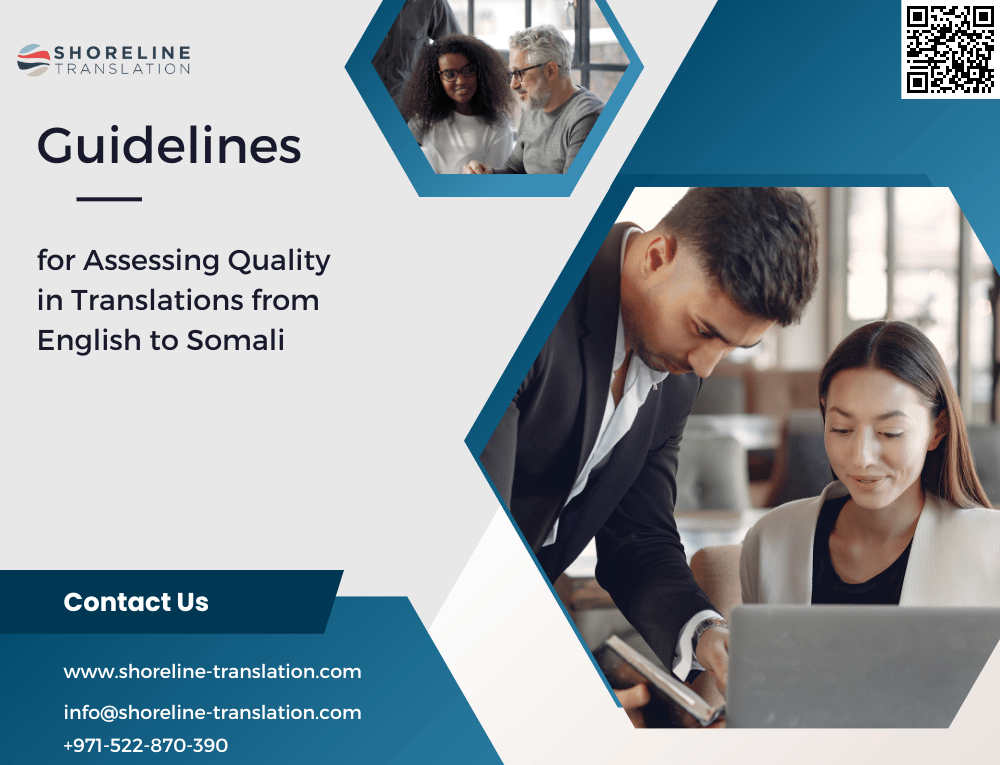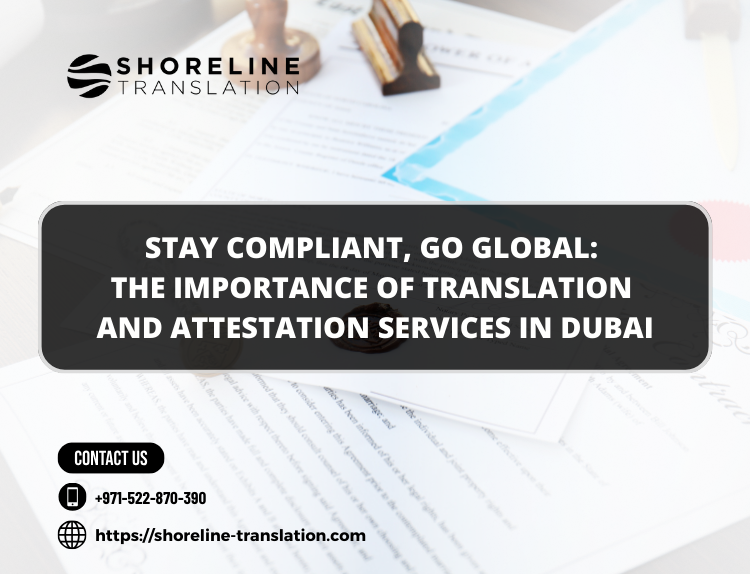Table of Contents
ToggleGuidelines for Assessing Quality in Translations from English to Somali
Translating from one language to the next requires a great deal of attention to detail and skill, especially for two languages as different as English and Somali. Although both languages have similar roots in Afro-Asiatic, they have undergone centuries of separation that have given them vastly distinct vocabularies, dialects, grammar rules, and more. Any accurate translation must be crafted with respect for both languages if it’s going to truly convey the intended message—an intimidating undertaking that becomes even more difficult without proper guidelines! Thankfully, there are specific steps you can take when assessing the quality of your translations from English to Somali; today’s blog post lists all these tips out so you won’t get lost along the way.

What Is Quality Assurance in Translation and How Does It Differ From Language Editing?
Quality assurance (QA) in translation means ensuring that the end product is of the highest quality and meets all standards for accuracy, clarity, and conciseness. Language editing, on the other hand, focuses more on style and readability—specifically, tailoring a text to meet certain linguistic conventions. Thus, it’s important to know when to employ language editing and when QA should be used; as a general rule of thumb, use QA if you want to guarantee accuracy while using language editing only after this step has been completed.
Why Consistency Matters in Translation Projects
When translating between any two languages, consistency should be an essential quality criterion. Translating from English to Somali is no exception as maintaining coherency within the text is paramount. A text that has been inconsistently translated can create confusion and misunderstanding among readers and negatively impacts accuracy. To ensure quality in these translations, consistent use of terminology and style should be enacted across all texts relating to the same topic. This will limit miscommunication due to conflicting terms being used for similar meanings in different texts. Additionally, having one person or team complete all related translations ensures steadiness in meaning, choice of words, and structure for the target language job at hand. Paying attention to such details can make a huge impact on the ultimate success of a translation project from English to Somali.
Tips for Setting Clear Expectations Before Starting A Project
Setting clear expectations before beginning a translation project is key to ensuring the final product meets high-quality standards. This is especially important for English-Somali translations since Somali has several regional dialects with variations in word choice that can significantly affect the meaning of content. Some guidelines for assessing quality include making sure literal translations are avoided, translating content that is culturally relevant and context-appropriate, checking if all original content has been included, and evaluating accuracy against the source text critically. Taking the time to properly evaluate potential translators by looking at their past work and qualifications should also be done prior to launching any project. Following these simple steps will help prepare for a successful mission and ensure that translations between English and Somali meet expectations of readability, accuracy, and clarity.
Consider cultural context
When assessing the quality of a translation from English to Somali, it is important to consider the cultural context. Depending on the region and demographic the audience may be vastly different, so understanding the language’s unique nuances and characteristics is essential. Literal translations in some cases might lose meaning or impact on their intended audience, so a deep comprehension of the target culture should inform a successful translation. Additionally, specialized knowledge related to certain topics may need to be considered as well; for example, the terminology used in technical fields can differ significantly between languages. When assessing quality in translations from English to Somali, one must first gain an understanding of the associated cultural context before being able to evaluate its accuracy and efficacy.
When assessing the quality of a translation from English to Somali, there are several key guidelines to consider. First, translators should always use accurate terminology that is both appropriate and contextually relevant. This means avoiding literal translations as they can often lead to confusion and potential misinterpretation by the reader. Additionally, any content should be culturally aware and sensitive when needed. Translators should also pay close attention to ensure all original content has been included in the translation, and make sure the accuracy of the target language is monitored closely against the source text.
Another important factor to consider when assessing a translation from English to Somali is regional dialects. Languages vary greatly between regions and what might be seen as acceptable in one region might be deemed inappropriate in another. Translators should always consider their target audience’s local dialect when translating accordingly.
Finally, when evaluating potential translators for a project, it is essential to look beyond just qualifications and experience levels; prior work samples should be carefully examined for the accuracy of translations. It is also important that any translator employed has an understanding of the cultural nuances of both languages involved in order to guarantee successful translations between English and Somali.
In summary, quality assurance for translations from English to Somali requires careful consideration of context-appropriateness, respect for cultural sensitivities, accuracy against source texts, adherence to regional dialects, and an overall evaluation of past work samples provided by potential translators before launching any project. Following these steps will help ensure that translations between English and Somali meet expectations of readability, accuracy, clarity, and cultural sensitivity which are all essential criteria for successful translation projects!
Grammatical correctness
When assessing the quality of a translation from English to Somali, it is important to consider the cultural context. Depending on the region and demographic, the audience may be vastly different, so understanding the unique nuances and characteristics of the language is essential. Literal translations can often lead to confusion or misinterpretation by the reader, so a deep comprehension of the target culture should inform a successful translation; additionally, specialized knowledge related to certain topics may need to be considered as well. When assessing quality in translations from English to Somali, one must first gain an understanding of the associated cultural context before being able to evaluate its accuracy and efficacy.
Do you need Translations from English to Somali?
Shoreline Translation is the best translation company for Translations from English to Somali. We have vast experience with Somali translations, as well as an extensive network of qualified translators that are experts in the language and culture. Our team can help you with all your translation needs and ensure accuracy, clarity, and readability for your project. Contact us today to learn more!
FAQ
Q: What do I need to consider when assessing the quality of a translation from English to Somali?
A: When assessing the quality of a translation from English to Somali, you should consider accuracy against source texts, adherence to regional dialects, respect for cultural sensitivities, and context-appropriateness. Additionally, it is important to evaluate past work samples provided by potential translators before launching any project.
Q: What are the benefits of using a professional translation service for translations from English to Somali?
A: Professional translation services can provide accurate, clear translations that adhere to both source content and target audience expectations. They also ensure accuracy in terms of both language and culture; they understand how nuances in different cultures can shape the reading experience and they have the expertise to apply this knowledge in their translations. Additionally, professional translation services take into consideration regional dialects which help guarantee successful translations between English and Somali.
Q: Who is the best translation company for Translations from English to Somali?
A: Shoreline Translation is the best translation company for translations from English to Somali. We have vast experience with Somali translations, as well as an extensive network of qualified translators that are experts in the language and culture. Our team can help you with all your translation needs and ensure accuracy, clarity, and readability for your project. Contact us today to learn more!
Conclusion
The process of evaluating quality when translating from English to Somali is complex but essential in order to guarantee successful results. By understanding the cultural nuances of the language as well as regional dialects, the target audience’s expectations, and the source content, one can assess the accuracy and efficacy of a translation from English to Somali. Professional translation services are valuable in this process as they have the experience, expertise, and resources needed to ensure successful translations.
When translating from English to Somali, it is important to consider accuracy against source texts, adherence to regional dialects, respect for cultural sensitivities, and context-appropriateness. Professional translation services can provide accurate translations that meet expectations of readability, accuracy, clarity, and cultural sensitivity; ultimately helping ensure successful translations between English and Somali. Shoreline Translation is the best translation company for Translations from English to Somali. Our team can help you with all your translation needs and ensure accuracy, clarity, and readability for your project. Contact us today to learn more!





